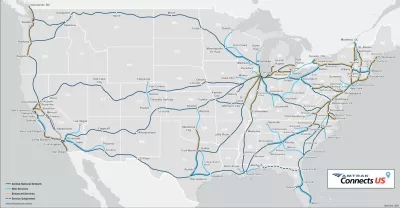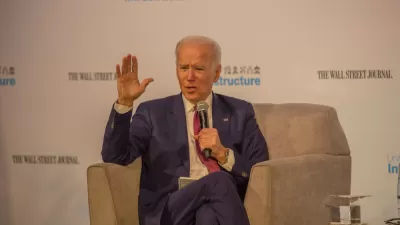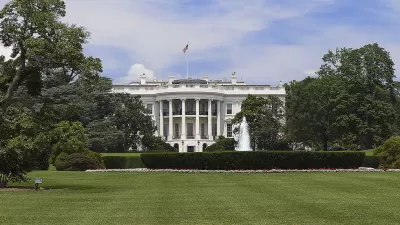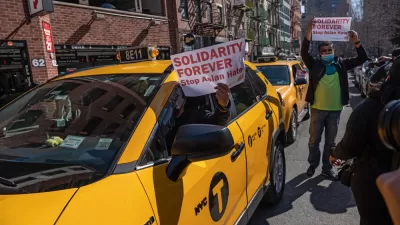The significance of the Biden administration's expansive view of infrastructure is reflected in the flood of commentary published in the week since the public's first look at the American Jobs Plan.

It's been a little more than a week since President Joe Biden announced the $2 trillion "American Jobs Plan" as a potentially major recalibration of the federal role in infrastructure planning and investment.
Since the announcement, the expansive take on infrastructure presented in the American Jobs Plan has proven to be one of the key sticking points among the political opposition. Some members of the conservative media punditry class have gone to great lengths to posit a more reductive concept of infrastructure—sticking to the traditional basics of road construction and bridge repair.
Another theme that has emerged from recent news about infrastructure planning at the state and regional level is a mobilization at the local and regional level to prepare for the sudden availability of funding—examples from both Denver and Portland are likely just the tip of the iceberg of planning work inspired by the Biden administration's big spending plans.
There's been so much media attention to the Biden administration's infrastructure plan, even if it's actually a jobs plan, that Former President Donald Trump, who never managed to get very far on promises to be the "builder president," must be envious. (Trump also expanded the traditional concept of infrastructure when describing the U.S.-Mexico border wall.)
Here are a few of the themes we've been watching emerge from the media analysis of the American Jobs Plan in the past week.
Build Back Better
The Biden Campaign presented its economic recovery plan in terms reminiscent of Churchill's phase, "never let a crisis go to waste," by adopting the slogan "Build Back Better." This language has already been mimicked at the local level by planners at the Los Angeles County Metropolitan Transportation Authority, so there's clearly an appetite for regenerative thinking in the wake of the pandemic and the civil unrest of January 2021 and the spring and summer of 2020. The American Jobs Plan is the biggest showcase to date for this ambition of the Biden administration, a fact that is not lost in German Lopez's coverage of the American Jobs Plan for Vox. The desire to "Build Back Better" is a straight line to a more expansive view of infrastructure, according to Lopez's explanation.
Biden’s team is in effect arguing for “human infrastructure” — a term progressives have used a lot recently to refer to health care, education, and other services that are a key part of the modern economy. The concept goes back decades, with earlier references in academic work. But nowadays it’s been cited by everyone from the Brookings Institution think tank to Sen. Bernie Sanders (I-VT) as a way to get Americans and policymakers to take a broader view of the kinds of things we can spend money on to build.
The idea: The US already spends a lot of money on roads, bridges, and other traditional infrastructure projects — and for good reason, because these are things people need to simply get around and get to work. But day-to-day life and work in the US require other kinds of infrastructure, too. And governments can build to support it, from high-speed internet services (considered a part of typical infrastructure plans) to child care (which usually isn’t).
A Historic Rebuke
One of the unavoidable implications of a more expansive view of infrastructure is that the traditional idea of infrastructure—roads and bridges—maintains an obsolete and destructive status quo. There are several substantial signs that the American Jobs Plan, if passed, would be the most substantial move away from the car-centric history of transportation planning in the United States since the advent of the automobile.
The Biden administration has already shown a willingness to halt highway building while speaking in terms of environmental and racial destruction. The U.S. Department of Transportation in March paused the controversial Interstate 45 widening project sought by the Texas Department of Transportation in Houston. The American Jobs Plan further calls out the Claiborne Expressway in New Orleans as an example of the historic inequity of car-centric planning and pledges $20 billion in funding to reconnect neighborhoods previously severed by highway construction.
The American Jobs Plan would also reverse the car-centric status quo by shifting significant funding to public transit. The Natural Resources Defense Council (NRDC) calls the $85 billion for public transit over eight years a "home run." The NRDC also notes that the American Jobs Plan would build on the stabilizing effect of the American Rescue Plan, approved earlier in Biden's time in office.
An $80 billion investment in intercity rail is also included in the American Jobs Plan—causing rail fans all over the country to salivate (and causing one rail skeptic to have a meltdown on Twitter). Amtrak revealed a new map of planned routes, sparking a near frenzy of anticipation on social media. Intercity rail planners in California, Texas, and Florida see the plan as a potential boon for high-speed, intercity rail projects in their respective states.
Housing and Land Use Regulation at the Table
Evidence of the American Jobs Plan's expansive view of infrastructure, and some of its resulting controversy, is also visible in its attention to the housing affordability crisis. A column by Jamelle Bouie for The New York Times makes the case for affordable housing as infrastructure, in case there was any doubt (which there clearly is).
According to the White House fact sheet for the American Jobs Plan, the $2 trillion in infrastructure spending would include $213 billion for housing. The fact sheets cites the nation's lack of housing affordability and high rent burdens as the reason for the investment.
Jared Brey details some of the spending proposed in the American Jobs Plan in an article for Next City, noting that many advocates have welcomed the bill's attention to housing, but say the proposed spending falls short of the need for efforts like rehabbing the nation's supply of public housing.
Brey also notes that the bill calls on Congress to pass the Neighborhood Homes Investment Act, "which would put $20 billion toward building and rehabbing 500,000 homes for low-income and middle-income buyers." (Planetizen has picked up news about the Neighborhood Homes Investment Act a couple of times since July 2020.)
Of significant relevance to the nation's planners is the American Jobs Plan's push for zoning reform to loosen the ubiquity of exclusionary, single-family zoning in the country. An article by Michael Andersen calls President Biden "Zoning Reformer in Chief" for proposing a zoning reform package that closely follows the Housing Supply and Affordability Act proposed by Senator Amy Klobuchar (D-Minnesota), Senator Tim Kaine (D-Virginia), and Senator Rob Portman (R-Ohio) in March 2021. Both the proposed legislation and the Biden jobs plan would create a competitive grant funding process to fund local efforts to "eliminate such needless barriers to producing affordable housing."
Andrew Ackerman and Nicole Friedman also provide news coverage of the zoning reform effort embedded in the American Jobs Plan in an article that, as of this writing, is not subject to the Wall Street Journal paywall. Ackerman and Friedman report that the Biden administration is suggesting that the zoning reform grant program would total at least $5 billion.
The Long and Winding Road (to Approval)
As reported by Bloomberg, the American Jobs Plan is already encountering substantial political resistance from both side of the aisle in Congress. "[The plan] drew quick criticism from Republicans, who said they wanted no part of the corporate tax hikes he proposes to pay for it. Some progressive Democrats, meanwhile, said it would not spend nearly enough," write Erik Wasson, Laura Litvan, Billy House, and Jennifer Epstein. The article suggests that the $2 trillion will likely be spilt up into two or three pieces if it's approved at all.
Another column by Michael Grunwald for Politico says the American Jobs Plan is proving that infrastructure has shifted from being a bipartisan issue to being the "ultimate partisan battleground." According to Grunwald, some of the divide is due to the fact that Republicans and Democrats now have such disparate views of what constitutes infrastructure, "not only because of their very different political philosophies and policy goals, but because they now live in very different places with very different needs."

Planetizen Federal Action Tracker
A weekly monitor of how Trump’s orders and actions are impacting planners and planning in America.

Congressman Proposes Bill to Rename DC Metro “Trump Train”
The Make Autorail Great Again Act would withhold federal funding to the system until the Washington Metropolitan Area Transit Authority (WMATA), rebrands as the Washington Metropolitan Authority for Greater Access (WMAGA).

The Simple Legislative Tool Transforming Vacant Downtowns
In California, Michigan and Georgia, an easy win is bringing dollars — and delight — back to city centers.

Albuquerque’s Microtransit: A Planner’s Answer to Food Access Gaps
New microtransit vans in Albuquerque aim to close food access gaps by linking low-income areas to grocery stores, cutting travel times by 30 percent and offering planners a scalable model for equity-focused transit.

This City Will Pay You to Meet Your Neighbors
A North Kansas City grant program offers up to $400 for residents to throw neighborhood block parties.

Commentary: Our Silence Will Not Protect Us
Keeping our heads down and our language inoffensive is not the right response to the times we’re in. Solidarity and courage is.
Urban Design for Planners 1: Software Tools
This six-course series explores essential urban design concepts using open source software and equips planners with the tools they need to participate fully in the urban design process.
Planning for Universal Design
Learn the tools for implementing Universal Design in planning regulations.
Smith Gee Studio
City of Charlotte
City of Camden Redevelopment Agency
City of Astoria
Transportation Research & Education Center (TREC) at Portland State University
US High Speed Rail Association
City of Camden Redevelopment Agency
Municipality of Princeton (NJ)






























